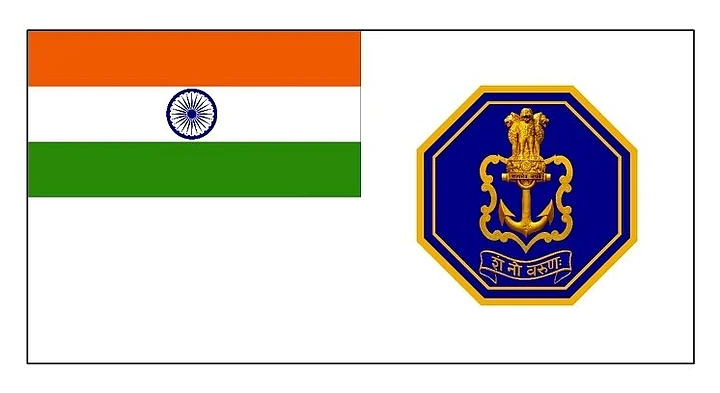Prime Minister Narendra Modi, on Friday, 2 September, unveiled a new Indian Navy ensign at the Commissioning event of INS Vikrant, the first indigenously designed and built aircraft carrier at the Cochin Shipyard Limited.
According to a statement from the Prime Minister’s Office (PMO), the new Naval ensign (Nishaan), which befits Indian maritime heritage, is an attempt to move away from India’s colonial history.
The new ensign replaces the current one which carries the Saint George’s Cross with the Tricolour at the canton (top left corner of the flag).
What is the new Naval ensign and its significance? Why did we do away with the previous ensign? Has such a change been witnessed before? Here’s all you need to know.
What is a naval ensign?
Essentially, a naval ensign is a flag hoisted atop all the institutions of the navy, including naval warships, ground stations, and air bases.
Every country has its own ensign. The United States Navy’s ensign is the same as their national flag, but several other naval forces have distinctive ensigns which are featured on their war vessels.
What is the new Indian Navy ensign?
The new Indian Naval ensign features the Tricolour at the top left, with the Indian Navy crest in an octagon, representing Chhatrapati Shivaji Maharaj's rajmudra, replacing the Saint George's Cross.
What is the significance of the new ensign?
According to the Indian Navy, the blue octagonal shape represents eight directions, symbolising the Indian Navy's multi-directional reach and multi-dimensional operational capabilities, while the anchor represents "steadfastness."
The octagonal shape with twin golden borders draws inspiration from the seal of the Indian emperor, Chhatrapati Shivaji Maharaj, whose visionary maritime outlook established a credible naval fleet.
The navy said that Shivaji Maharaj's fleet was comprised of "60 fighting ships and approximately 5,000 men."
They added that the rising Maratha naval power during Shivaji Maharaj's period "was the first to secure the coastline against external aggression."
What was the Indian Navy's ensign?
The Indian Navy ensign, which has now been changed, had the Cross of Saint George intersecting at the centre of the flag with the state emblem of India at the intersection, and the Tricolour at the upper left canton.
What was the history behind the previous Indian Navy ensign?
The previous ensign succeeded the pre-independence ensign of the Indian Navy, which featured the red Saint George’s Cross on a white background with the Union Jack (flag) of the United Kingdom in the top let corner.
Post Independence, on 15 August 1947, the Indian defence forces kept the British colonial flag and badges. It was on 26 January 1950 that the ensign was changed to the Indian pattern.
The only changes to the flag were the replacement of the Union Jack with the Tricolour and the addition of the navy crest.
Why the change?
According to the PMO’s statement, the change in the Indian Naval ensign is a nod towards India’s move towards ‘Atmanirbharta’.
Moreover, the step is the latest attempt to "move ahead," as part of the PM's efforts to dispose off India’s colonial past and history.
At the 2022 Independence Day, Modi reinforced the need for steps like this, as he set out “an India free of colonial mindset” as one of New India’s Panch Pran in the Amrit Kaal.
Has the Indian Navy ensign been changed before?
The Naval ensign saw a change in 2001. While the Tricolour was retained at the top left corner, Saint George’s Cross was replaced with the Indian Navy’s crest in the middle of the flag.
This was a long pending demand for a change in the ensign, with the original suggestion stemming from Vice Admiral VEC Barboza, who retired from the Navy as the Flag Officer Commanding-in-Chief Western Naval Command.
In 2004, the ensign was changed back to the Saint George’s Cross following complaints that the new flag was indistinguishable because of the Navy crest merging with the sea and the skies.
Moreover, another change was made in the flag. The red Saint George’s Cross now featured the state emblem in the middle.
In 2014, another change was made when ‘Satyamev Jayaye,’ in Devnagri script, was included on the flag below the Ashoka emblem.
Is India the only country to drop the Saint George’s Cross?
Most Commonwealth countries retained the Cross during their independence but several have now done away with featuring it on their naval ensigns. Prominently, the countries that dropped the Saint George’s Cross are:
Australia
New Zealand
Canada
The Royal Canadian Navy unveiled a new design in 2013 which featured the Canadian naval crest on a white background. Meanwhile, New Zealand and Australia did away with the Saint George’s Cross in 1967 and 1968 respectively.
What is the Saint George’s Cross?
The Red Cross on a white background is known as the Saint George’s Cross, and is named after a Christian Warrior Saint, who was reportedly a crusader during the Third Crusade. This cross also serves as the flag of England, which was adopted by them and the city of London in 1190 to identify English ships entering the Mediterranean.
The British Royal Navy adopted the Cross to fly on their ships, with the present pattern of the ensign being adopted in 1707.
